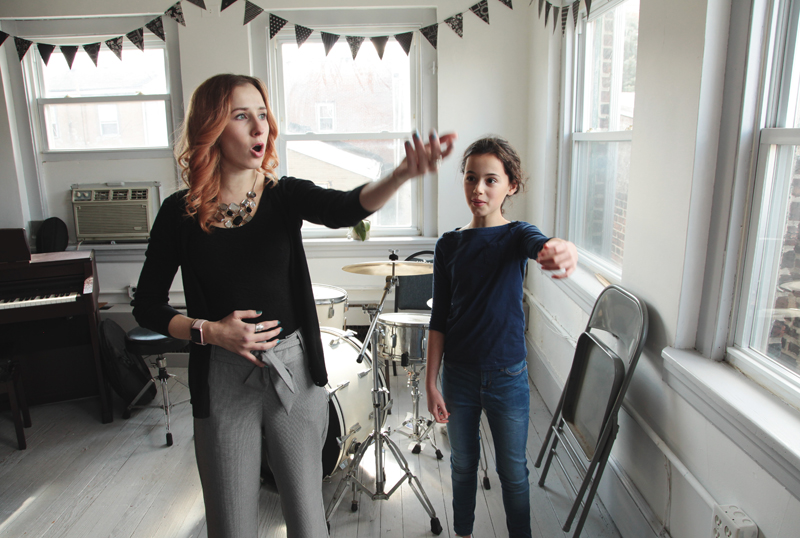
Stretches to Develop Good Posture for Singing
Singing well requires good breathing, but it means nothing if you don’t hold your instrument well. How do you hold your instrument as a singer? Through good posture of course! Good posture for singing may not mean what you think though.
A qualified voice teacher should address posture early on in voice lessons. You can get a head start on your voice lessons by using these stretches to develop good posture for singing right now. Not all voice teachers will address posture through stretches. However, these stretches will get you to the end result that your teacher will look for.
What is Good Posture for Singing?
Good posture for anything means you will hold your body in a position that allows you to do the activity at hand. A running posture allows you to move your legs freely. An instrumental posture allows you to play well. Therefore, posture for singing seeks to keep your lungs and throat open and relaxed so breath can flow freely to create an easy sound.
That means you’ll want to stand tall. Your feet should feel grounded and your knees relaxed. Your torso will feel open and expanded, and everything above your torso (such as your shoulders, neck, jaw, and tongue) will relax to the point of flexibility.
These goals are hard to achieve when actively thinking about each body part. Trying to follow these directives will most likely encourage tension and overthinking. Stretches, on the other hand, develop this posture organically without too much thought towards the end result.
Stretches to Develop Good Posture for Singing
Use these stretches as they are helpful to you. They work best in the morning, or right before a practice session or lesson. Do each exercise slowly and methodically to feel the full benefit, and to not throw your body out of alignment.
Reach for the sky – Start standing tall, then reach your arms over your head, aiming for a long stretch of the torso. If possible, stand on your toes to stretch your legs as well. Your whole body should feel especially long. Slowly lower your feet, then lower your arms to your side.
Rag doll – Rag dolls work similarly to a standing forward bend in yoga. First, lower your head so your chin touches your chest. Then let your shoulders sag forward. Now let your spine roll down one vertebrae at a time, as if your spine were a bendy straw. Keep going until every part of your body above your hips succumbs to gravity and brings you to a complete forward fold. You may bend your knees slightly as you do this. Stay here for a few moments, shaking out your shoulders and aiming for more stretch in your lower back. Then, slowly roll back up in the opposite order you came down in (in other words, your shoulders and head should be the last to come back up). Remember, the goal of this exercise is not to touch your toes or the floor, but instead to maximize the stretch and relaxation in the upper half of your body.
Knee bends – Place your feet hip width apart. Feel your entire foot on the ground. Then gently bend your knees so you feel bouncy in your legs. These are not squats. They are intended to loosen your knees so you do not lock them. You can also bend one knee at a time, which will add a shake to the hips.
Shoulder shrug – Many new singers believe they need to keep their shoulders back. If you tend to slouch, this may be helpful for you. It’s more important, however, for shoulders to be relaxed and even with your ears. To measure this, lift your shoulders to your ears in an exaggerated shrug. Then release. Repeat this a couple of times.
Head rolls – Drop your chin to your chest. Now gently roll your head to one side, then back, then to the other side, and back down again. Your head will roll in a full circle, stretching your neck. Repeat in the other direction. Do not try to stretch as far as you can go! This exercise is meant to build gentle flexibility.
Different teachers will have different methods to develop good posture for singing. The end result will more or less remain the same though. It’s important to have a teacher help you develop good posture for singing as well, as it will be difficult to know what you need help with on your own. While posture does not account for everything in singing, it can help you work out some technical issues right away. Give these stretches a try to see if your singing improves from them.
Kristen Seikaly
I teach voice. I started singing at a young age, first with school and community choirs, followed by high school concerts and musicals. I received my Bachelor's of Music at the University of Michigan in Vocal Performance, with a minor in French. Then, I earned my Master's of Music at Westminster Choir College in Voice Performance and Pedagogy. After my second degree, I moved to Philadelphia to pursue performance and teaching opportunities. I have performed in various Philadelphia venues including The Kimmel Center, The Academy of Music, and The Cathedral Basilica of Saints Peter and Paul. I have also participated in operatic productions with companies such as Opera Philadelphia, the Delaware Valley Opera Company, and Princeton Opera Alliance. I believe voice lessons should provide a thorough technical, musical, and emotional understanding of one’s voice. Comfortable singing always comes first, which begins with breathing and posture. I balance imagery and fact based on how a student learns and understands. Singing is joyful amongst all else. While I urge all of my students to reach certain technical goals, my main goal is to make sure the student is always achieving their personal goals and enjoying themselves at the same time.


